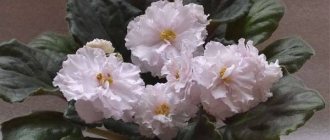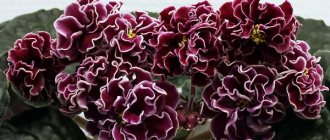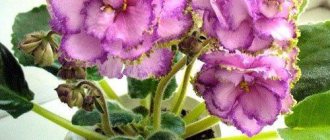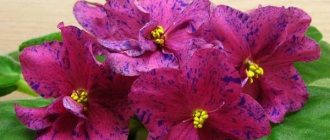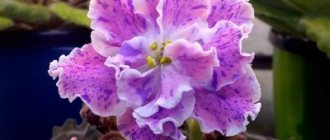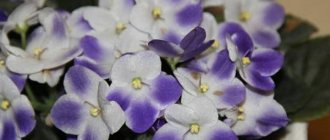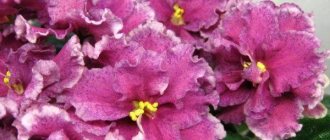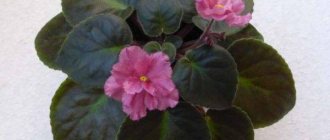Each variety by Tatyana Pugacheva is the result of painstaking work and strict selection. Due to this, they rarely give sports and develop well in different conditions.
Violet varieties PT-Spring Palitra, PT-Heavenly Tent, PT-Svetozara, PT-Larissa (T. Pugacheva) are no exception.
To successfully grow a rosette and obtain beautiful flowering, it is important to know its external characteristics and care features. In this case, you can make sure that the variety grown is correct and take all the best qualities from it.
Violet PT-Spring Palette
The socket is quite large, compact and neat. The sheets are quite close to each other. The shape of the plate is oblong, with small teeth, quilted and slightly curled towards the center. The color is quite dark, and the underside is light green.
Flowering is abundant and caplike. The flower stalks raise three or four buds to the center, which as they bloom become very large flowers.
The flower shape is usual double or semi-double with pronounced waviness along the edge of the petals.
The color is very delicate , which looks very laconic on a dark rosette. Pale pink petals are framed by a border-sprayed raspberry-lilac shade; sometimes a light green border appears along the edge , which appears only in cool conditions.
Features of care
The PT-Spring Palette is easy to care for, but there are several nuances that need to be taken into account:
- lighting - with a lack of light, the sheets stretch upward and curl more strongly. Therefore, it is better to keep this outlet under lamps;
- Temperature – moderate mode will give excellent rosette and flowering. But if there is a desire to get a light green corrugation along the edge of the flower, then the temperature is lowered by 2-5°C;
- watering - the variety develops well on all types of irrigation, but when switching to wick, there is a possibility of the bush overgrowing.
Reviews
Nadezhda, Omsk. “The first flowering pleased me with the marvelous beauty of the flowers. The rosette is even and symmetrical. The buds slowly opened and turned into large flowers that lasted a long time.”
Zinovieva Arina. “Two young rosettes bloomed, twins from the same cutting. The flowers bloomed almost simultaneously. Very delicate color, wonderful shape, they remind me of multi-tiered bows. The cuttings on the leaves are a little long, but this is more likely due to youth and lack of light; they live on my windowsill.”
Violet PT-Heavenly Tent
PT-Heavenly Tent has a smooth and beautiful rosette. In this case, a young bush often pulls the leaves upward, simultaneously stretching the petiole, but with good lighting this drawback disappears as it grows older.
The plate is round in shape, quilted, with barely noticeable teeth. The color is quite dark, but lightens a little at the edges.
Attention! In cool conditions the leaf becomes lighter in color.
The flowers are very large , simple and semi-double in shape with a wavy edge of the petals. The color is sky blue with a white center , and in cool weather it also has a border. The petals are painted unevenly, the blue shade spreads unevenly, in some places it is thicker, and in others it turns almost white.
Features of care
When caring for this variety, several nuances must be taken into account:
- The rosette needs a lot of light, it is better to grow it under a lamp. If there is not enough lighting, the sheets stretch upward and the socket loses its neatness;
- When it comes to watering, you should give preference to the classic one . On the wick or mats, the rosette may increase slightly, but the flowers will also become slightly larger;
- to obtain varietal flowering with a white border, the temperature is reduced by 2-5°C , and the leaves become slightly lighter.
Otherwise, caring for the PT-Heavenly Tent violet is no different from the standard.
Reviews
Olga. “I waited a long time for the first flowering of the baby, and it disappointed me a little. The flower stalks grew very high above the rosette, and all the flowers were simple. I liked the color and gives hope for proper flowering in future times. The petals are white and blue, but only at first glance, in reality only the middle and thin border are white, everything else is in different shades of blue.”
Nadezhda Illarionovna. “Delicate blue flowers on a very dark rosette, this combination looks incredibly beautiful. The flowers from the first bloom are very lush, although semi-double, and the color is simply incredible.”
Violet PT-Svetozara
PT-Svetozara is a variety with a smooth, neat rosette that is easy to form. The leaves are dark green, round, quilted with a cherry back and a smooth edge. The rosette is rarely even; usually young leaves rise slightly upward.
The flowers are very large , two or three on peduncles, which are collected in the center, forming a beautiful bouquet, and sometimes a hat. The shape of a double or semi-double flower is decorated with a corrugated edge. The color is soft pink, but not pale, and a light green border appears in places along the edge.
Important! The beautiful corrugated edge of PT-Svetozar is colored unevenly with a light green border and only in cool conditions.
Features of care
All requirements for caring for this variety coincide with the standard requirements for caring for Saintpaulias, but there are several clarifications that affect the external parameters:
- lighting - it is recommended to keep under lamps to avoid pulling and lifting of sheets;
- temperature - it should be reduced by 3-6°C and thus stimulate the appearance of a light green border.
The rim appears only at low temperatures.
Reviews
Oksana Anatolyevna. “I really liked PT-Svetozara. The first flowering immediately produced huge flowers and there were a lot of them, but as soon as the first few bloomed, I picked them so as not to torment the rosette. I spent a long time selecting the temperature to get a beautiful light green border, and for me it goes almost along the entire edge of the petal. A temperature of 20° was enough for this.”
Veronica Pavlovna. “I’ve been dreaming about this variety for a long time. I bought a leaf at an exhibition and anxiously waited for it to bloom. The first flowering pleased me with the size of the flower, but there was only one. Considering that the rosette bloomed very early, this is also good. All subsequent blooms delight with a cap of large, gorgeous flowers.”
Features of flowering, growth and reproduction
If the cultivation rules are followed, the variety has proven itself well. Flowering is long and bright. When breeding, the children quickly gain leaf mass and very rarely go into sports.
When the starter blooms, the flowers may not be as double as those of an adult rosette. Most often, the PT-Lucretia variety reveals its full flowering potential in the second flowering.
Blooming of an adult violet PT-Lucretia.
How long does it take to grow an adult plant?
You can grow a variety from leaf cuttings in 9-10 months.
How are varietal characteristics transmitted?
It conveys varietal characteristics well. Therefore, when propagating, mother cuttings are most often used , and they produce 2-3 children.
Flowering in hot and cool conditions
In cool conditions, the PT-Lucretia variety shows a beautiful green border along the edge of the wavy petals. In hot conditions the border becomes white, or may become completely invisible.
What do flower stalks look like?
Peduncles are strong, not too long . Quite large flowers hold up well.
Is it possible to achieve cap flowering?
With proper care, the variety readily blooms with a dense cap . But most often, young rosettes in the first flowering do not reveal the full potential of the variety.
Bud lifespan
The bud remains fresh for 2-3 weeks , so it is very easy to achieve beautiful lush flowering.
The flowers do not fade for up to three weeks.
Violet PT-Larissa
The variety is very spectacular due to the abundance of flowering and the size of the flowers. The peduncles are very strong and bear 5-9 buds in the center of the rosette, which, even when fully opened, do not lower their heads and do not fall on the leaves.
The flower size is about 7 cm and this is very attractive considering their number. The color is quite interesting, white flowers and a violet-lilac center , which occupies half of the petal. The shape is also attractive - semi-double with a wavy edge.
The rosette matches the flowers, very even, neat and slightly smaller in size than the standard. The leaves are medium green, quilted with a lightly toothed edge.
Features of care
One of the least demanding varieties:
- natural lighting on the windowsill is completely enough to form an ideal outlet;
- The color of flowers depends little on temperature. The lilac center may slightly decrease or increase, but these changes may not be noticed.
Reviews
Nikolaeva Larisa. “I once came across the PT-Larissa violet online - the photo and description of its advantages took up quite a lot of space and I firmly decided to buy it. What to say? The variety is simply delightful. There are so many colors and such a large size that you can fall in love with it just for that. And there is also a beautiful color, in which the tenderness is simply off the charts.”
Natalya, Bryansk. “When I bought a baby of this variety, I didn’t take into account that it was similar to the LE-Jeanne variety. I was even disappointed when I realized this at home. I decided to wait for flowering and was very happy. The middle of the varieties has a different shade, LE-Jeanne has blue, and PT-Larissa has lilac. If you do not take into account the color of the flowers, the variegation of Le Jeanne also makes a difference. If you study the flowers in detail, there is a difference in the shape of the flower.
I decided to keep both varieties, they are like sisters in my eyes, as if they were similar, but at the same time different.”
Violet at the North Pole
One morning at the North Pole, the Polar Bear smelled some unusual smell in the air and told Ursa Major (and Ursa Minor is his daughter) about it:
– Has any expedition arrived again?
But it turned out that this was not the case. It turned out that the cubs found a violet. She was very small, shivering from the cold, but continued to exude her aroma, because this was her profession, her calling.
- Dad! Mother! Come here! – the cubs called their parents and showed them their amazing find.
“I immediately said that something was wrong here,” noted the Polar Bear. - In my opinion, this is not a fish.
“I’m not sure about this,” answered the Big Dipper, “but it’s not even a bird.”
“You’re right too,” said the Bear, after thinking for a while.
By evening, news spread throughout the North Pole: a small, strange, fragrant, lilac-colored creature had appeared in the vast icy desert. It rested on only one single leg and did not move.
Walruses and seals gathered to look at the violet, deer arrived from Siberia, musk oxen from America, and white foxes, wolves, and sea magpies arrived from very distant lands.
Everyone admired the unfamiliar flower, its trembling stem, everyone inhaled its aroma with pleasure. And the strangest thing is: there was enough of a wonderful smell for everyone - and for those who kept coming and coming. There were as many of them as before.
“Since she exudes so much aroma,” said one walrus, “it means she must have a whole supply of it under the ice.”
“I told you right away, there’s something hiding here!” - exclaimed the Polar Bear.
He didn't say exactly that, but no one remembered that.
The seagull, who was sent south to find out something about the strange phenomenon, returned and said that a small fragrant creature is called a violet and that in some countries millions of such violets grow.
– Well, this is nothing new for me! – the walrus noticed. “The question is different: how did she get here?” I'll tell you what I think about this: I just don't know which fish to grab!
- I didn't understand. What did he want to say? – Polar Bear asked his wife.
“He wanted to say that he didn’t know what fish to grab.” In other words, he is completely at a loss.
- Here! - exclaimed the Polar Bear. – This is exactly what I think about this!
That night there was a terrible roar over the North Pole. The eternal ice trembled and, like glass, broke into pieces. The violet exuded such a wonderful aroma and such a strong one that it seemed as if she decided to immediately, in one day, melt this entire huge icy desert in order to turn it into a warm azure sea or a green velvet meadow. The poor thing worked so hard that her strength was exhausted. By dawn she withered, her head drooped, she lost her color, and with it her life.
If we translated into our language what she thought at the last minute, it would sound something like this: “Here I am dying... But it doesn’t matter. It is important that someone started the fight... And one fine day millions of violets will bloom here. The ice will melt, and islands will appear, covered with meadows and flowers, and children will run around them...”
